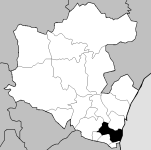Sacavém
| Sacavém | |||
| Civil Parish (Freguesia) | |||
|
The Trancão River winding through the heart of Sacavém
|
|||
|
|||
| Official name: Freguesia de Sacavém | |||
| Name origin: šagabi Arabic word for next or in the neighbourhood; latinised to sacabis, -is, becoming sacabem in the accusative case, and through phonetic modifications Sacavém; Arabic sources indicate that the use of the word Šaqabān | |||
| Country | |||
|---|---|---|---|
| Region | Lisboa | ||
| Subregion | Grande Lisboa | ||
| District | Lisbon | ||
| Municipality | Loures | ||
| Center | Sacavém | ||
| - elevation | 25 m (82 ft) | ||
| - coordinates | 38°47′40″N 9°6′19″W / 38.79444°N 9.10528°WCoordinates: 38°47′40″N 9°6′19″W / 38.79444°N 9.10528°W | ||
| Length | 3.34 km (2 mi), Northwest-Southeast | ||
| Width | 1.77 km (1 mi), Southwest-Northeast | ||
| Area | 4.09 km2 (2 sq mi) | ||
| Population | 17,659 (2001) | ||
| Density | 4,318/km2 (11,184/sq mi) | ||
| Vila/Town | 7 December 1927 | ||
| - Cidade/City | 4 June 1997 | ||
| Timezone | WET (UTC0) | ||
| - summer (DST) | WEST (UTC+1) | ||
| Postal Zone | 2685-099 | ||
| Area Code & Prefix | (+351) XXX XXX XXX | ||
| Demonym | Sacavenense; Sacaveno | ||
| Patron Saint | Nossa Senhora da Purificação | ||
|
Location of the parish of Sacavém in the municipality of Loures
|
|||
| Website: http://www.jfsacavem.pt | |||
| Statistics from INE (2001); geographic detail from Instituto Geográfico Português (2010) | |||
Sacavém (Portuguese pronunciation: [sɐkɐˈvɐ̃j]; Arabic: شقبان) is a former civil parish in the municipality of Loures, Lisbon District, Portugal. In 2013, the parish merged into the new parish Sacavém e Prior Velho. It is a few kilometers northeast of the Portuguese capital, Lisbon. The civil parish covers an area of 4.09 km2 (1.6 sq mi), and included as of 2001 Census a resident population of 17,659 inhabitants. The region is known for its famous ceramics industry.
Due to its strategic location, at the intersection of several roads from the north and east connecting to Lisbon, Sacavém was an important settlement during periods of Portuguese History, with some evidence extending back to pre-history. The Portuguese historian Pinho Leal wrote, in his chorography Portugal Antigo & Moderno (Ancient & Modern Portugal), that "Sacavém is incontestably a very old settlement, and already existed in the time of the Romans". The oldest known references date back to the Neolithic and Chalcolithic: three polished stone axes were discovered from the Bronze Age, and in the mid-1980s, excavations in the historical centre of the city revealed a cave with similar artifacts from this period.
By the first century, Sacavém was already crossed by two major Roman roads that connected the region with the interior of the Iberian Peninsula:
...
Wikipedia




